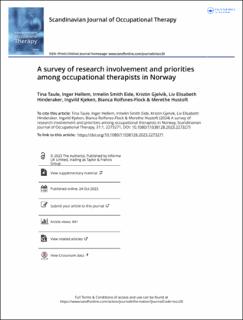| dc.contributor.author | Taule, Tina | |
| dc.contributor.author | Hellem, Inger | |
| dc.contributor.author | Eide, Irmelin Smith | |
| dc.contributor.author | Gjelvik, Kristin | |
| dc.contributor.author | Hinderaker, Liv Elisabeth | |
| dc.contributor.author | Kjeken, Ingvild | |
| dc.contributor.author | Rolfsnes-Flock, Bianca | |
| dc.contributor.author | Hustoft, Merethe | |
| dc.date.accessioned | 2024-02-26T08:10:23Z | |
| dc.date.available | 2024-02-26T08:10:23Z | |
| dc.date.created | 2024-01-02T12:08:22Z | |
| dc.date.issued | 2023 | |
| dc.identifier.citation | Tina Taule, Inger Hellem, Irmelin Smith Eide, Kristin Gjelvik, Liv Elisabeth Hinderaker, Ingvild Kjeken, Bianca Rolfsnes-Flock & Merethe Hustoft (2024) A survey of research involvement and priorities among occupational therapists in Norway, Scandinavian Journal of Occupational Therapy, 31 (1) | en_US |
| dc.identifier.issn | 1103-8128 | |
| dc.identifier.uri | https://hdl.handle.net/11250/3119783 | |
| dc.description.abstract | Background: Involvement in research and shared priorities among occupational therapists (OTs) can enhance the quality of occupational therapy practice.
Aims: To explore the research involvement and research priorities of OTs in Norway.
Materials and methods: An online survey comprising 14 open-ended and closed questions was made available to participants at the Seventh Norwegian Congress in Occupational Therapy to fill out.
Results: Out of 633 congress participants, 307 (49%) OTs completed the survey. Among the respondents, ∼40% were involved in research. The most commonly reported area of research was rehabilitation. Research involvement was associated with employment in education or specialist healthcare services and with greater work experience and post-bachelor’s degree education. The most frequently prioritized research question addressed the effect of occupational therapy. Unmet needs and factors conducive to increasing OT’s involvement in research were identified.
Conclusions and significance: The survey revealed that a considerable, but uneven, distribution of OTs were involved in research. To encourage greater participation in research, researchers, decision-makers, and employee associations should take steps to make research more appealing to OTs. The research priorities highlighted by Norwegian OTs align with those stated by OTs in other countries. | en_US |
| dc.language.iso | eng | en_US |
| dc.publisher | Taylor & Francis | en_US |
| dc.rights | Navngivelse 4.0 Internasjonal | * |
| dc.rights.uri | http://creativecommons.org/licenses/by/4.0/deed.no | * |
| dc.subject | research | en_US |
| dc.subject | priorities | en_US |
| dc.subject | OT | en_US |
| dc.subject | occupational therapy | en_US |
| dc.subject | evidence-based practice | en_US |
| dc.title | A survey of research involvement and priorities among occupational therapists in Norway | en_US |
| dc.type | Peer reviewed | en_US |
| dc.type | Journal article | en_US |
| dc.description.version | publishedVersion | en_US |
| dc.rights.holder | ©2023 The Author(s). Published by Iinforma UK Limited, trading as Taylor & Francis Group | en_US |
| dc.source.pagenumber | 1-11 | en_US |
| dc.source.volume | 31 | |
| dc.source.journal | Scandinavian Journal of Occupational Therapy | en_US |
| dc.source.issue | 1 | |
| dc.identifier.doi | 10.1080/11038128.2023.2273271 | |
| dc.identifier.cristin | 2218828 | |
| dc.source.articlenumber | 2273271 | en_US |
| cristin.ispublished | true | |
| cristin.fulltext | original | |
| cristin.qualitycode | 1 | |

